

Historical Development
![]()
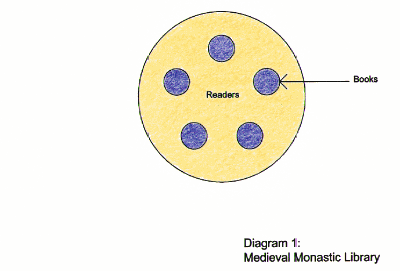
Given
![]() Limited numbers of books
and readers
Limited numbers of books
and readers
![]() No service component;
i.e., all readers serve as their own reference librarians, no book
check-out, books chained to lecterns for security, etc.
No service component;
i.e., all readers serve as their own reference librarians, no book
check-out, books chained to lecterns for security, etc.
Features
![]() Books are dispersed
throughout the reading area
Books are dispersed
throughout the reading area
![]() Books and individual
readers are collocated, with book cupboards and chained books on
lecterns
Books and individual
readers are collocated, with book cupboards and chained books on
lecterns
17th and 18th Century
Hall Library
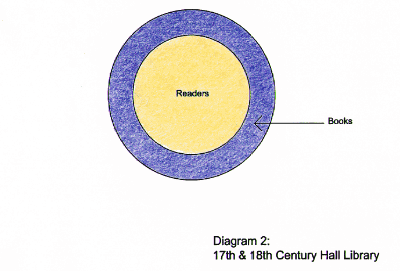
Given
![]() Increasing numbers of
books and readers requiring consolidation of books
Increasing numbers of
books and readers requiring consolidation of books
![]() Limited size of
collections still does not require a service component
Limited size of
collections still does not require a service component
Features
![]() Concentric organization of
books around the perimeter of the reading area with readers surrounded
by books
Concentric organization of
books around the perimeter of the reading area with readers surrounded
by books
![]() Introduction of book
stacks to accommodate larger numbers of books in these areas
Introduction of book
stacks to accommodate larger numbers of books in these areas
19th Century
Closed Stack Library
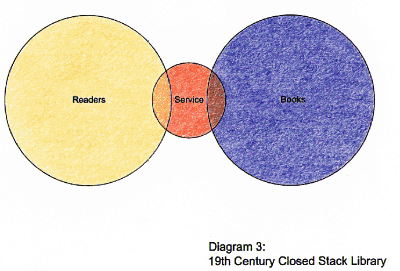
Given
![]() Dramatically increasing
numbers of books and readers
Dramatically increasing
numbers of books and readers
![]() Introduction of a new
service component for cataloging, circulation, and security
Introduction of a new
service component for cataloging, circulation, and security
Features
![]() Separation of books from
reading area for efficient consolidation of stacks
Separation of books from
reading area for efficient consolidation of stacks
![]() Introduction of a separate
service component for efficient and controlled access to books
Introduction of a separate
service component for efficient and controlled access to books
![]() Readers separated from
books
Readers separated from
books
20th Century
Open Stack Library
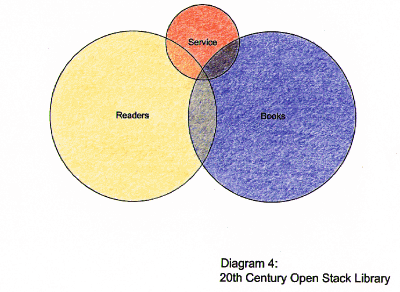
Given
![]() Proliferation of free
public libraries causes increase in numbers of books and readers
Proliferation of free
public libraries causes increase in numbers of books and readers
![]() Subsequent need for direct
public access to books
Subsequent need for direct
public access to books
Features
![]() Stacks are still
consolidated, but are now open to the reading area for public access
Stacks are still
consolidated, but are now open to the reading area for public access
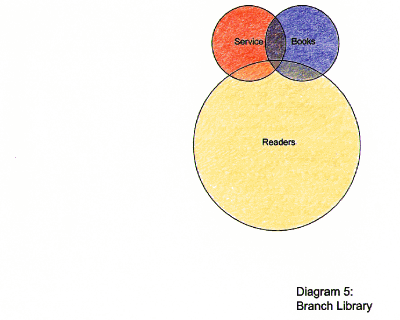
Given
![]() Decentralization of
library functions for community and neighborhood access
Decentralization of
library functions for community and neighborhood access
![]() Resulting decrease in
number of books on site
Resulting decrease in
number of books on site
Features
![]() Corresponding decrease in
size of stack area and related service functions.
Corresponding decrease in
size of stack area and related service functions.
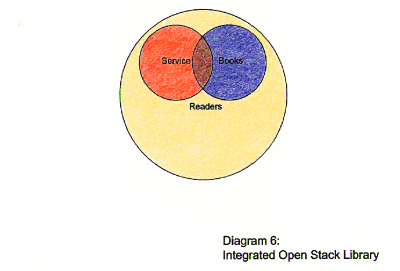
Given
![]() Increasing demand for
public access to information
Increasing demand for
public access to information
![]() Fewer books and a decrease
in circulation and reference assistance as a result of
Fewer books and a decrease
in circulation and reference assistance as a result of
![]() new electronic information
storage and access technology
new electronic information
storage and access technology
![]() Increase in the variety
and scope of reader activities as the library diversifies to accommodate
different kinds of activities
Increase in the variety
and scope of reader activities as the library diversifies to accommodate
different kinds of activities
Features
![]() Decrease in the size of
book storage and service areas
Decrease in the size of
book storage and service areas
![]() Increase in the size of
reader activity area
Increase in the size of
reader activity area
![]() Integration of books and
service directly into the reading area
Integration of books and
service directly into the reading area
Electronic Library
of the Future
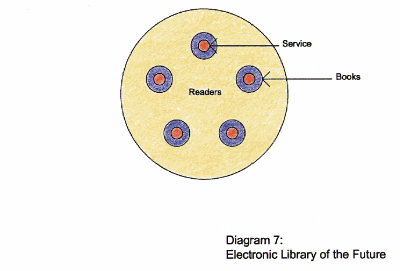
Given
![]() Dramatic increase in the
amount and accessibility of information through electronic media
Dramatic increase in the
amount and accessibility of information through electronic media
Features
![]() Decentralization of
information access and reference components — dispersal of information
‘smart points' throughout the library
Decentralization of
information access and reference components — dispersal of information
‘smart points' throughout the library
![]() Reference and service
functions are relegated to the reader
Reference and service
functions are relegated to the reader
![]() Similarity to the
organization of medieval library
Similarity to the
organization of medieval library